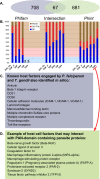In silico identification of specialized secretory-organelle proteins in apicomplexan parasites and in vivo validation in Toxoplasma gondii
- PMID: 18974850
- PMCID: PMC2575384
- DOI: 10.1371/journal.pone.0003611
In silico identification of specialized secretory-organelle proteins in apicomplexan parasites and in vivo validation in Toxoplasma gondii
Abstract
Apicomplexan parasites, including the human pathogens Toxoplasma gondii and Plasmodium falciparum, employ specialized secretory organelles (micronemes, rhoptries, dense granules) to invade and survive within host cells. Because molecules secreted from these organelles function at the host/parasite interface, their identification is important for understanding invasion mechanisms, and central to the development of therapeutic strategies. Using a computational approach based on predicted functional domains, we have identified more than 600 candidate secretory organelle proteins in twelve apicomplexan parasites. Expression in transgenic T. gondii of eight proteins identified in silico confirms that all enter into the secretory pathway, and seven target to apical organelles associated with invasion. An in silico approach intended to identify possible host interacting proteins yields a dataset enriched in secretory/transmembrane proteins, including most of the antigens known to be engaged by apicomplexan parasites during infection. These domain pattern and projected interactome approaches significantly expand the repertoire of proteins that may be involved in host parasite interactions.
Conflict of interest statement
Figures



Similar articles
-
Cryogenic electron tomography reveals novel structures in the apical complex of Plasmodium falciparum.mBio. 2024 Apr 10;15(4):e0286423. doi: 10.1128/mbio.02864-23. Epub 2024 Mar 8. mBio. 2024. PMID: 38456679 Free PMC article.
-
Toxoplasma gondii Vps11, a subunit of HOPS and CORVET tethering complexes, is essential for the biogenesis of secretory organelles.Cell Microbiol. 2015 Aug;17(8):1157-78. doi: 10.1111/cmi.12426. Epub 2015 Mar 12. Cell Microbiol. 2015. PMID: 25640905
-
Plasmodium rhoptry proteins: why order is important.Trends Parasitol. 2013 May;29(5):228-36. doi: 10.1016/j.pt.2013.03.003. Epub 2013 Apr 6. Trends Parasitol. 2013. PMID: 23570755 Review.
-
Toxoplasma gondii HOOK-FTS-HIP Complex is Critical for Secretory Organelle Discharge during Motility, Invasion, and Egress.mBio. 2023 Jun 27;14(3):e0045823. doi: 10.1128/mbio.00458-23. Epub 2023 Apr 24. mBio. 2023. PMID: 37093045 Free PMC article.
-
Signalling mechanisms involved in apical organelle discharge during host cell invasion by apicomplexan parasites.Microbes Infect. 2012 Aug;14(10):820-4. doi: 10.1016/j.micinf.2012.05.007. Epub 2012 May 23. Microbes Infect. 2012. PMID: 22634343 Review.
Cited by
-
Discovery of New Microneme Proteins in Cryptosporidium parvum and Implication of the Roles of a Rhomboid Membrane Protein (CpROM1) in Host-Parasite Interaction.Front Vet Sci. 2021 Dec 13;8:778560. doi: 10.3389/fvets.2021.778560. eCollection 2021. Front Vet Sci. 2021. PMID: 34966810 Free PMC article.
-
Total and putative surface proteomics of malaria parasite salivary gland sporozoites.Mol Cell Proteomics. 2013 May;12(5):1127-43. doi: 10.1074/mcp.M112.024505. Epub 2013 Jan 16. Mol Cell Proteomics. 2013. PMID: 23325771 Free PMC article.
-
Galactose recognition by the apicomplexan parasite Toxoplasma gondii.J Biol Chem. 2012 May 11;287(20):16720-33. doi: 10.1074/jbc.M111.325928. Epub 2012 Mar 7. J Biol Chem. 2012. PMID: 22399295 Free PMC article.
-
Subcompartmentalisation of proteins in the rhoptries correlates with ordered events of erythrocyte invasion by the blood stage malaria parasite.PLoS One. 2012;7(9):e46160. doi: 10.1371/journal.pone.0046160. Epub 2012 Sep 25. PLoS One. 2012. PMID: 23049965 Free PMC article.
-
A systems biological view of intracellular pathogens.Immunol Rev. 2011 Mar;240(1):117-28. doi: 10.1111/j.1600-065X.2010.00998.x. Immunol Rev. 2011. PMID: 21349090 Free PMC article. Review.
References
-
- Levine ND. Progress in taxonomy of the Apicomplexan protozoa. J Protozool. 1988;35:518–520. - PubMed
-
- Montoya JG, Liesenfeld O. Toxoplasmosis. Lancet. 2004;363:1965–1976. - PubMed
-
- Carruthers VB, Sibley LD. Sequential protein secretion from three distinct organelles of Toxoplasma gondii accompanies invasion of human fibroblasts. Eur J Cell Biol. 1997;73:114–123. - PubMed
-
- Carruthers VB. Armed and dangerous: Toxoplasma gondii uses an arsenal of secretory proteins to infect host cells. Parasitol Int. 1999;48:1–10. - PubMed
Publication types
MeSH terms
Substances
LinkOut - more resources
Full Text Sources

